Last Updated on 03/11/2023 by Dochlaggie. Post first published on May 22, 2023.
This is a question that many pet owners have been pondering: when do Pomeranians stop growing? It can be challenging to know for sure, but there are some factors that you can look at to determine if your Pomeranian is done growing.
Pomeranian growth usually will slow or cease by the time they are 12 months old. Most Pomeranian growth is mainly between 2 months and 12 months. Some Poms keep growing until they’re 18 months.
Many elements affect Pomeranian growth in the manner in which they do, particularly food, environment, and genetics.
How Can You Tell When is a Pomeranian Fully Grown?
Poms are one of the cutest canines in the world for numerous reasons, and size plays a vital role in cuteness. They’re small, puffed balls of energy. At 12 months, you usually have a Pomeranian fully grown.
If you are concerned about your Pomeranian puppy’s weight gain, please check out our Pomeranian growth chart.
Discover Your Pomeranian’s Full Size with Our Easy-to-Use Pomeranian Growth Chart
Pomeranians do not have a noticeable size difference between males and females, making it difficult to estimate their full size.
However, our Pomeranian weight chart can help you predict their size based on weekly growth since birth. Even if you don’t know their birth weight, you can still use the chart based on their current weight and age group, though it may be less accurate.
Remember that growth rates vary for each puppy, so don’t worry if your Pom is slightly ahead or behind the estimates. As long as your Pomeranian is healthy, that’s all that matters.
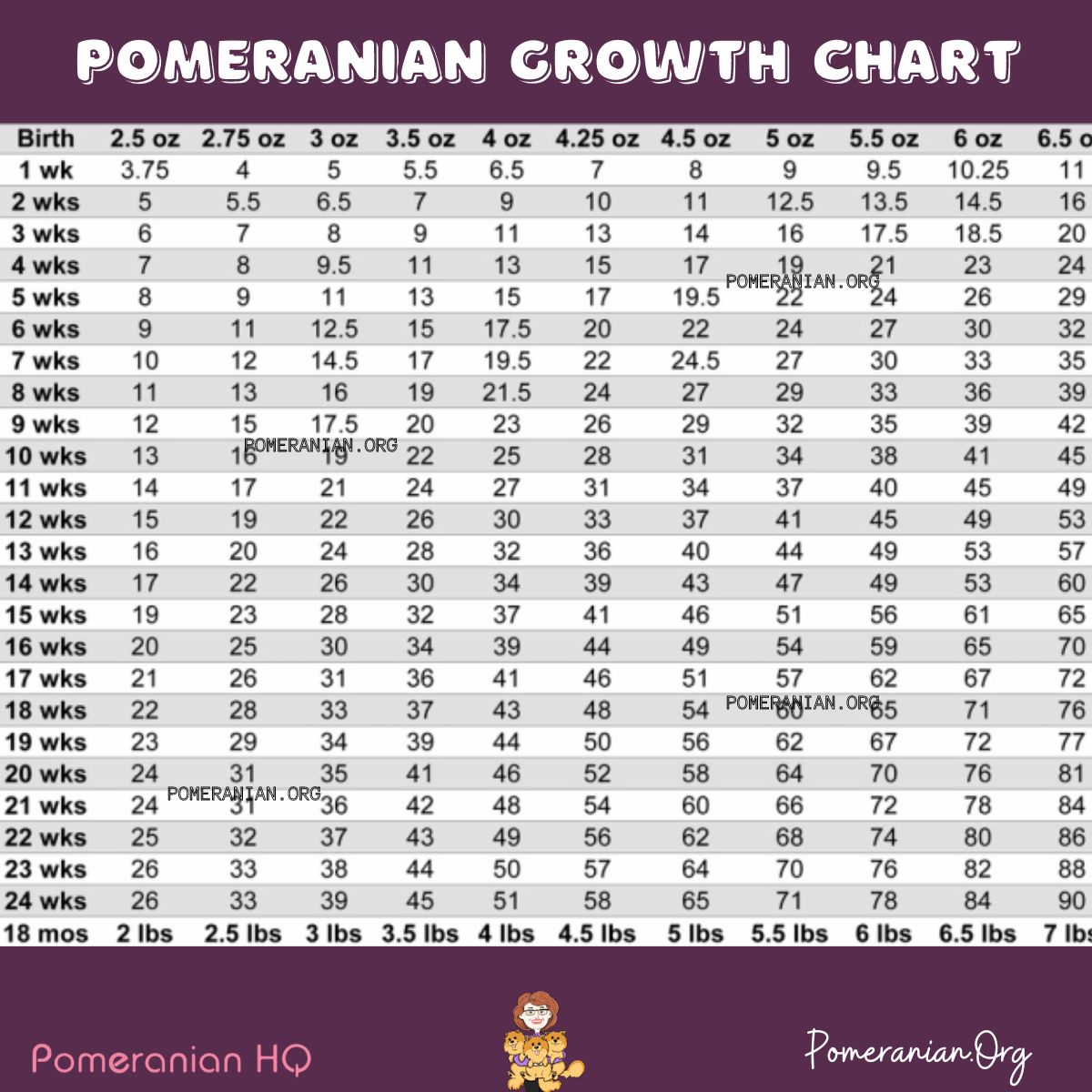
Newborn Pomeranian Size
Most newborn Pomeranians are so small when born; you could easily hold one in your hand. At birth, they’ll weigh a few ounces. It’s extremely tiny, but that size won’t last very long.
During this time, Poms double in size in just a few days, and this rapid growth continues until they’re eight weeks of age. That’s when they begin a new growth stage as they’re officially a Pom puppy.
Pomeranian Puppy Stages
Once Pomeranians are eight weeks of age and begin this puppy growth stage, they’ll grow slower than when they were only babies, but this is the period in which they grow most.
1 Year Old Pomeranian
This period continues until they’re 12 months of age and are officially Pomeranian adults. You will notice your Pom’s height and width growth and how their body becomes leaner. During the puppy period, there will occasionally be growth spurts and a couple of pauses in growth. It’s all normal, so don’t worry about it.
There are Pomeranians that will keep growing past the 12-month point, but it’s not a typical event. Some Pomeranians continue to grow past the 1-year mark, but this isn’t common. It’s usually a tiny Pomeranian with a slow growth rate when it happens.
Larger puppies often mature early and have finished growing at an early age. On the other hand, smaller Pomeranian puppies often grow longer and may not reach maturity until 14 to 16 months of age.
Senior Pomeranian
At eight years of age, Pomeranians enter their golden or senior years; it’s possible for them to be a little smaller than they were as an adult. However, there’s no cause for concern; they won’t shrink back to the size they were when born.
There are things happening to older Poms during this phase. They’re not as active as they were, meaning they have a reduction in the density of their muscles. A Pom’s normally puffy coat becomes a lot less puffy. Overall, it means they’re slowing down, not shrinking.
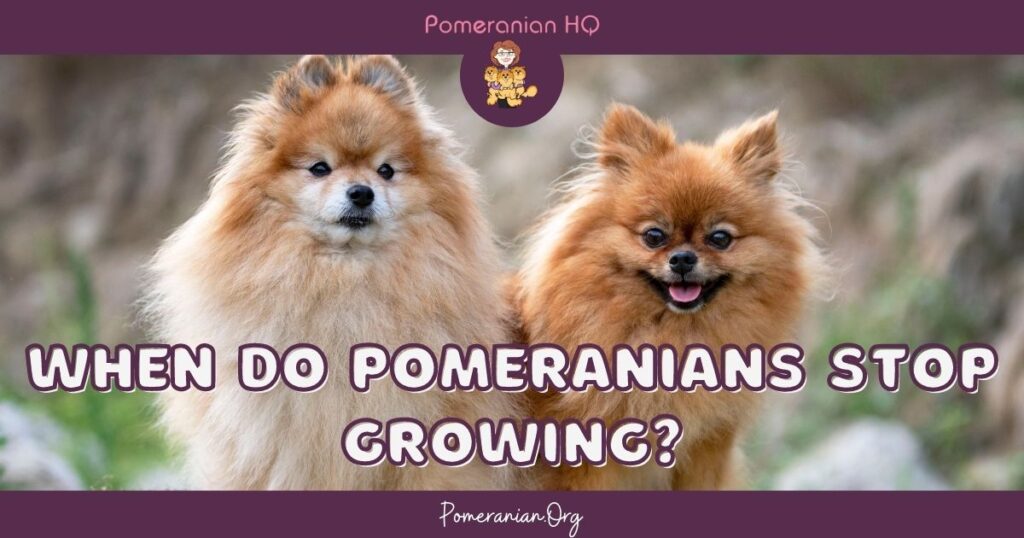
Factors That Affect Pomeranian Growth
Numerous elements help assess how big your Pomeranian will grow as an adult. Aspects that aren’t in our control include the dimensions, weight, and speed of growth. However, there are certain effects that can be influenced.
Genes
The most critical element that influences a Pomeranian’s growth is genetics. The ancestors of Pomeranians are Arctic working dogs, which play a major role in their size, temperament, and health. To see how big your Pom may become as an adult, look at the size of his parents and grandparents.
I say grandparents because inherited genes can skip a generation. The bottom line is that you can go back five generations to find attributes that can affect your Pomeranian’s growth.
Nutrition
Another vital element is nutrition. To achieve your Pomeranian’s final size and weight, you must feed him the right quality and quantity of food.
Be careful with his food, and ensure he doesn’t get off-limits or certain human foods. I strongly recommend high-quality, natural choices for Pomeranian puppies or small breeds.
Exercise
In addition, he should get sufficient exercise. Taking him for walks daily is a terrific way to do it, but you may also have other ideas.
Exercise can help boost his immune system as it exercises his muscles, respiratory system, and overall health. It reduces his chances of becoming sick.
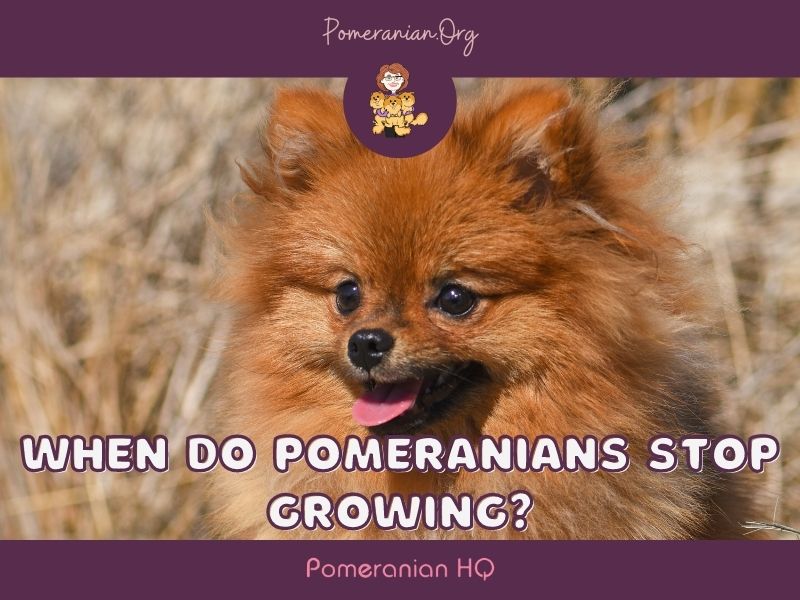
How Much Do Pomeranians Weigh Full-Grown?
A Pomeranian’s fully grown weight mainly relies on genes, the quality, and quantity of the food he consumes, how much he has exercised, and more. Generally speaking, Pomeranian weight is between 3 and 7 pounds.
Many Poms weigh 6-7 pounds, while others weigh less. Bigger Pomeranians may weigh 12-14 pounds. Although I mentioned numerous elements affecting growth, genetics is the primary one.
The weight of a Pomeranian is also independent of their size at birth. Any puppy’s final adult Pomeranian size is one of the hardest factors to assess. Birth weight has very little to do with your puppy’s adult size.
Big Pomeranian puppies often become small adult Pomeranians, and the reverse often happens.
Pomeranian puppies born from outcrosses are even harder to predict. Make sure you assess the Pomeranian size over a lengthy period. Growth spurts and plateaus could mislead you enormously if you’re not careful.
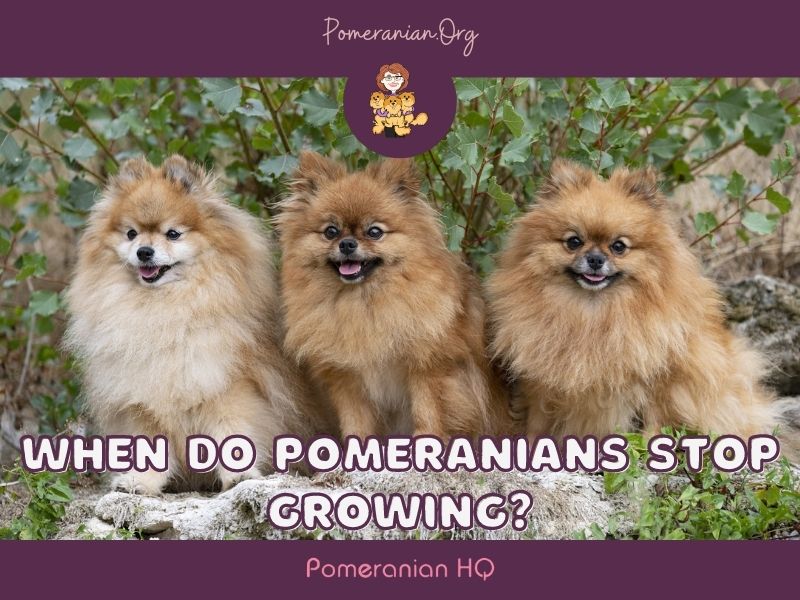
Some Pomeranians End Up Bigger Than Others
Pomeranian full-grown size and weight will usually be the same as the majority. Many Pomeranians will be larger or smaller than a typical dog.
It’s not normal, but occasionally you’ll find a puppy weighing as little as 3 pounds (he is tiny even for a Pomeranian.
Most people will call this a teacup, toy, or miniature Pomeranian. However, these aren’t official breeds. These tiny animals face a much higher risk of problems affecting their health.
This is a good reason for following the instructions previously mentioned. They’re definitely described as cute in smaller sizes, but they’re not the healthiest dogs to own. In fact, good Pom breeders specifically won’t breed these tiny Poms.
The bigger Pomeranians are described as interesting. Most Pomeranians that are bigger than the breed standard are often the result of poor breeding practices.
It is advisable to look at both parents before purchasing a Pomeranian puppy. The final size of a Pomeranian puppy is usually around the size of his parents.
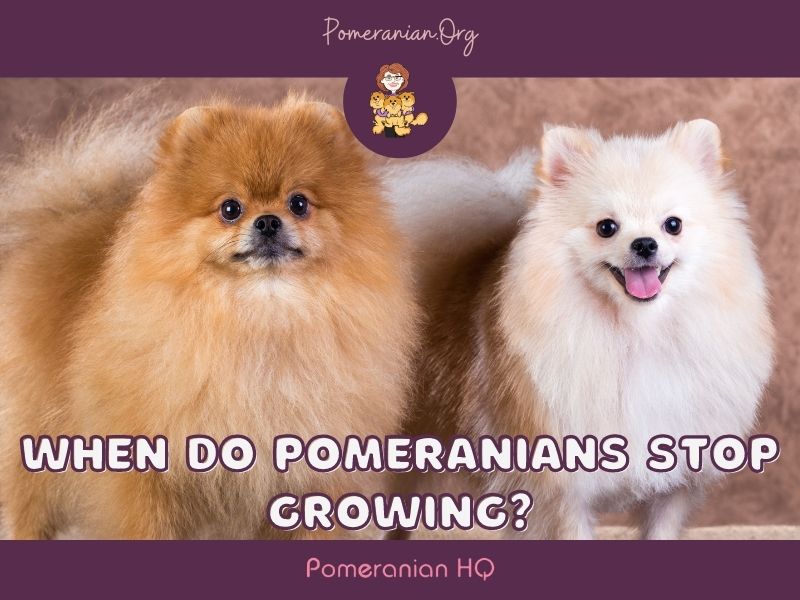
What is The Height of Pomeranian Dogs?
The height of Pomeranian dogs is about 8 to 12 inches tall.
Pomeranian’s Life Expectancy?
The Pomeranian life span depends on genetics, exercise, quality/quantity of food he consumes, health problems, and environment. The average Pomeranian life span is 12-16 years.
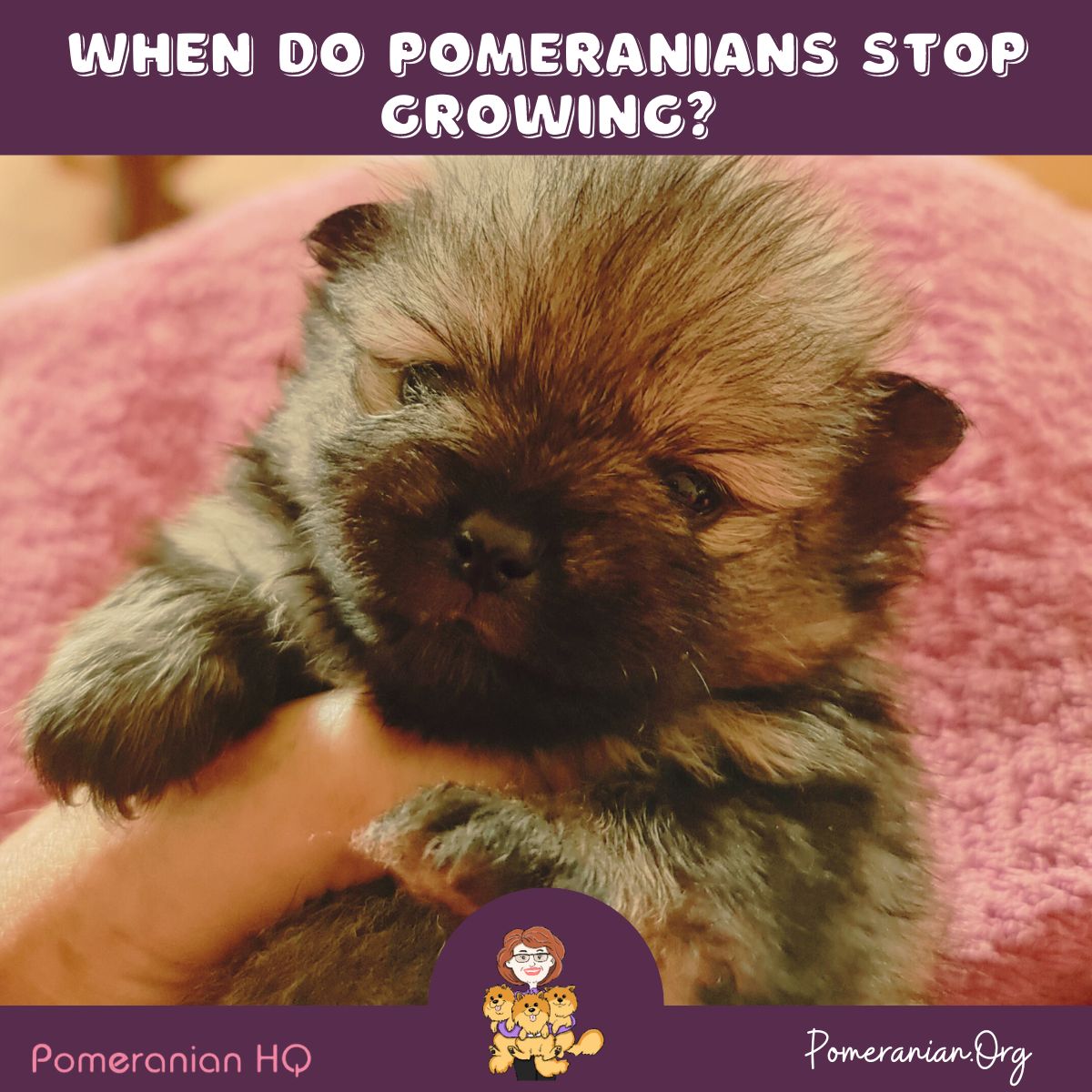
Conclusion
In conclusion, it’s essential to understand the growth stages of a Pomeranian during its lifetime. The correct diet and exercise are vital for their development, as these can help improve muscle tone and prevent obesity.
Knowing when your Pomeranian has stopped growing can help you plan for any additional support they may need regarding nutrition and changing their diet from puppy food to an adult diet.
Considering their small stature, it’s also essential to pay attention to the size of their toys and accessories, as they should be appropriate for them.
Although some breeds may grow faster or slower than others, all puppies eventually reach adult sizes by the age of one year old.
Ultimately, your pet will bring joy into your life, and with a bit of patience and understanding, you’ll have a faithful companion for years to come.
As you can see, it’s not always simple to determine when a Pomeranian’s growth is complete. But there are some key things that owners should be aware of to make the best decision for their dog.
Hopefully, this article has answered questions about canine growth rates and where to find additional information on how big your pup will get.
Copyright Pomeranian.org. All Rights Reserved.
References and Further Reading:
Official Standard of the Pomeranian (AKC). American Kennel Club, 2011.
English Kennel Club Pomeranian Breed Standard, 2017.
Denise Leo, The Pomeranian Handbook.








